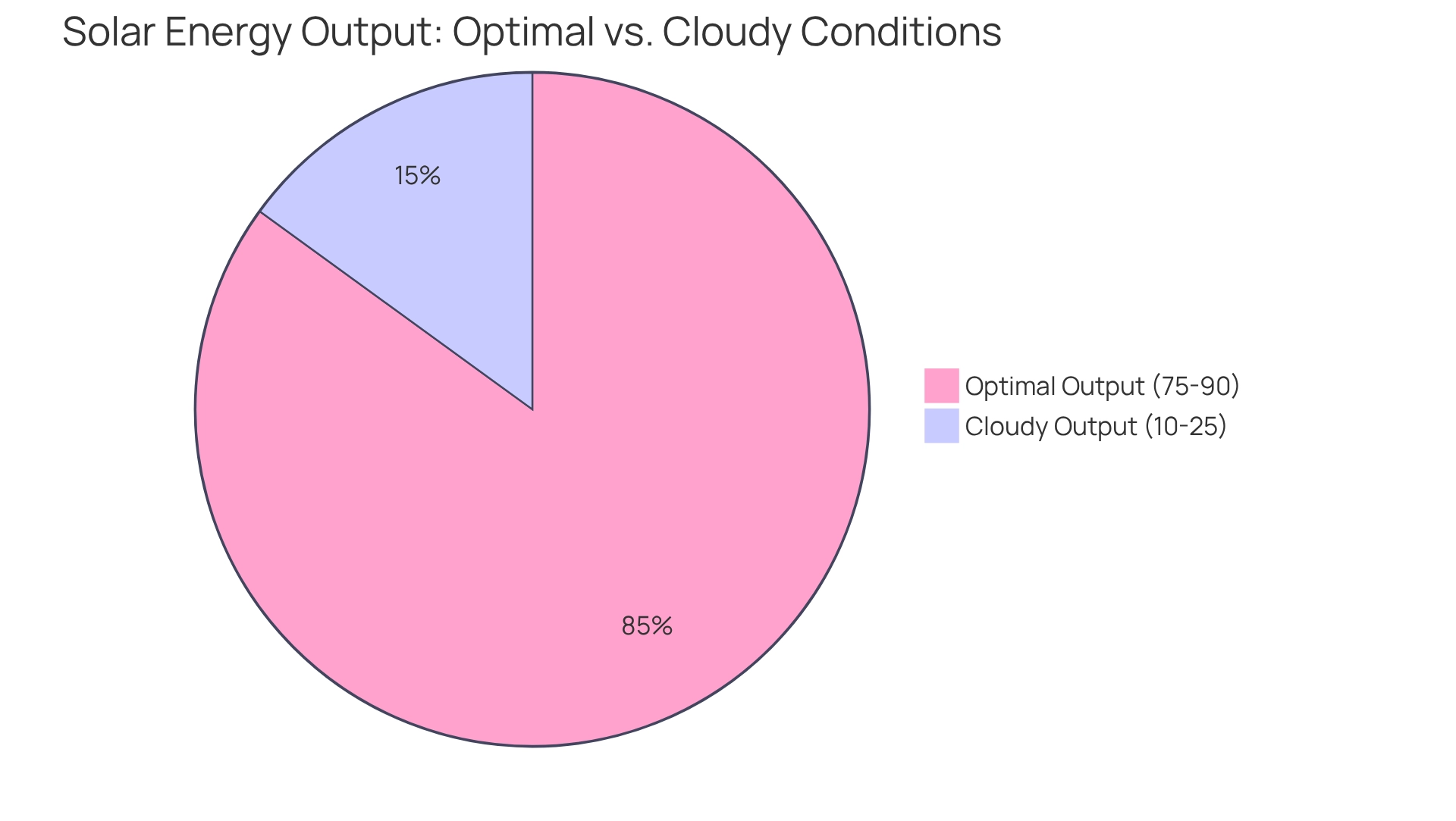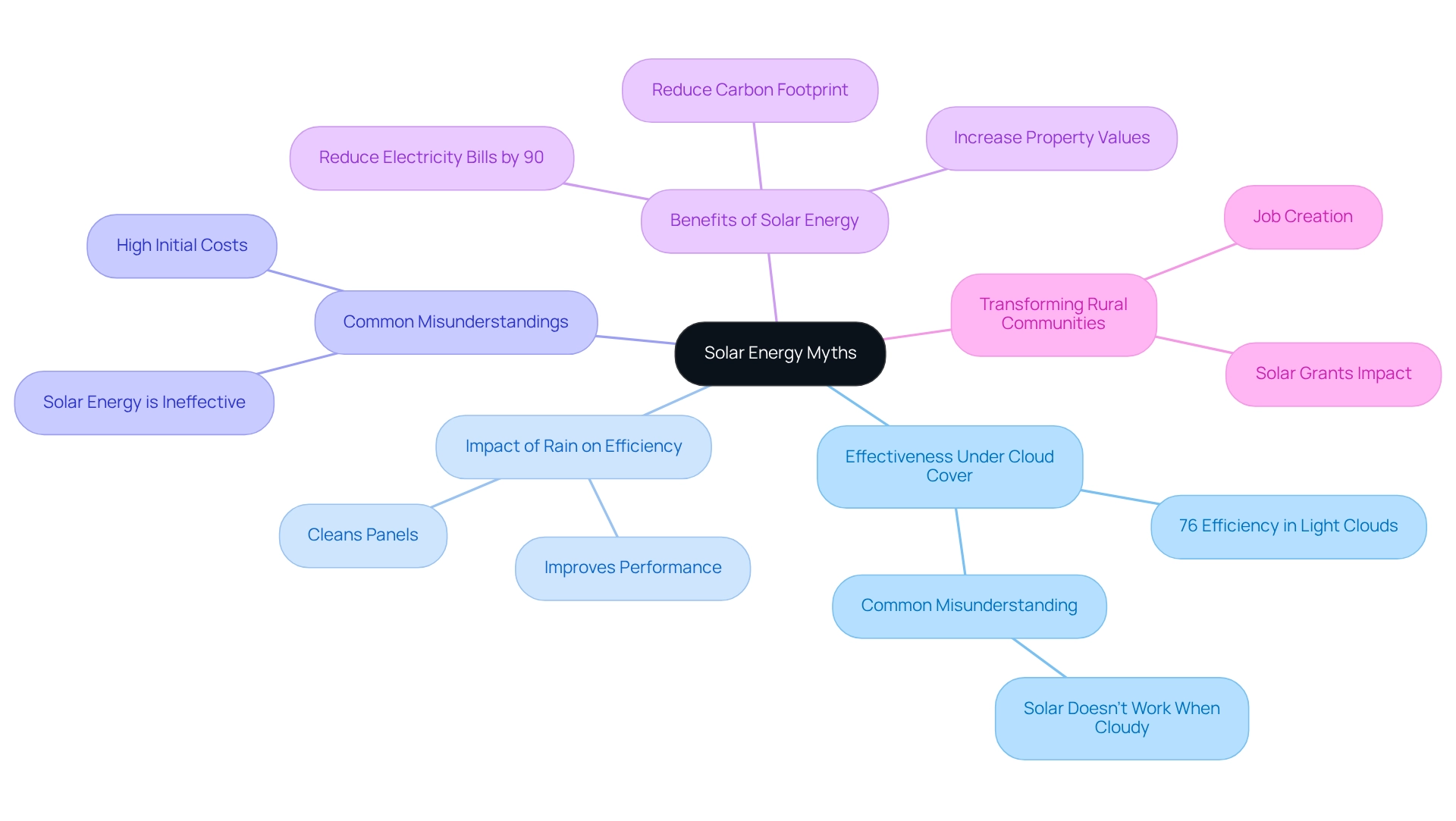Overview
We understand that many homeowners are concerned about rising energy bills, especially when the skies are overcast. It’s comforting to know that solar panels continue to function effectively even in cloudy conditions, producing approximately 10-25% of their usual output. This is made possible by their remarkable ability to capture both direct and diffuse sunlight.
As we explore the benefits of solar energy, it’s important to highlight advancements in photovoltaic technology, such as bifacial panels, which can significantly enhance energy generation. Additionally, factors like cloud density and proper installation can further optimize performance under these conditions.
Together, we can navigate these advancements and work towards energy independence. It’s common to feel uncertain about investing in solar energy, but the potential for reduced energy bills and a more sustainable lifestyle is truly within reach. By embracing solar technology, you’re not just making a choice for your home; you’re contributing to a greener future for all of us. Let’s take this journey together, and if you have any questions or need guidance, please don’t hesitate to reach out. We’re here to support you every step of the way.
Introduction
In the quest for sustainable energy, we understand that many homeowners are concerned about rising energy bills. Solar power stands as a beacon of hope, even when the skies are gray. Contrary to common belief, solar panels continue to generate electricity under cloudy conditions, albeit at a reduced capacity. This article delves into the mechanics of solar panel performance during overcast weather, exploring how advancements in technology and strategic installation can optimize energy capture.
By debunking myths surrounding solar energy and examining the key factors that influence efficiency, we aim to provide you with a clearer understanding of how to harness solar power effectively, regardless of the weather. With insights into the advantages of solar energy, even in less-than-ideal conditions, we encourage you to shift your perspective.
Together, we can highlight the potential for significant savings and environmental benefits that come with adopting renewable energy solutions. Let’s work towards a brighter, more sustainable future.
Understanding Solar Panel Performance in Cloudy Weather
We understand that managing energy bills can be a source of concern for many homeowners. Solar devices are here to offer a nurturing solution, transforming sunlight into electricity through photovoltaic cells. The question of whether arises, as these systems remain operational even on overcast days, though with a slight reduction in efficiency. It’s reassuring to know that they can capture both direct and diffuse sunlight, and this leads to the question: does solar still work when it’s cloudy, since diffuse sunlight is the gentle, scattered light that filters through clouds. Studies show that photovoltaic systems can still produce around 10-25% of their usual output in cloudy weather, leading to the inquiry of whether solar still works when it’s cloudy. For instance, a 10kW photovoltaic system installed in Seattle can generate approximately 8,900 kWh each year, illustrating that renewable power production persists even when the weather isn’t perfect.
Innovations in photovoltaic technology, such as bifacial panels, enhance performance during overcast conditions by collecting light from both surfaces. This means that even reflected power, which would otherwise go to waste, is efficiently utilized. It’s amazing to see how this innovation has shown particularly effective results in optimizing power capture on those cloudy days, which raises the question: does solar still work when it’s cloudy? While cloudy conditions may reduce sunlight output, it’s important to remember that power generation is still possible. Homeowners can effectively harness sunlight, raising the question of whether solar still works when it’s cloudy, ensuring a dependable source of energy even when the sun is hidden. This capability not only leads to ongoing savings but also contributes to a sustainable future for power. Together, we can explore customized solutions tailored to your needs. We encourage you to reach out to local energy firms in Stockton, who can provide the guidance and expertise necessary to enhance your solar system’s performance, even in less-than-ideal environmental conditions. Let’s work towards a brighter, more sustainable future together.
Debunking Myths: Solar Energy and Cloud Cover
It’s common to feel concerned about energy bills, especially when considering renewable energy options. A widespread misunderstanding is whether photovoltaic systems are effective and does solar still work when it’s cloudy, which may dissuade homeowners from exploring these sustainable solutions. In reality, photovoltaic systems can produce electricity, which raises the question: does solar still work when it’s cloudy? Research shows they can operate at approximately 76% of their rated capacity under light cloud cover. Moreover, rain can actually improve panel efficiency by removing dust and debris that may obstruct sunlight. Understanding these truths empowers homeowners to make informed decisions regarding energy investments, including the question of , which eases worries about performance during unfavorable weather.
At Powercore Electric, we have over 30 years of experience serving California communities, and we are dedicated to delivering outstanding service and local knowledge in energy solutions. Our programs, including energy grants, are transforming rural communities and showcasing the broader impact of renewable technology. Together, we can ensure that energy systems remain effective, addressing the question of whether solar still works when it’s cloudy. So, let’s work towards a brighter, more sustainable future for your home. If you have any questions or need guidance, please reach out to us—we’re here to help you every step of the way.
Key Factors Affecting Solar Energy Generation on Cloudy Days
We understand that many homeowners are concerned about rising energy bills and whether solar still works when it’s cloudy, as well as the impact of weather on their energy production. The effectiveness of photovoltaic systems on overcast days leads to the question of whether solar still works when it’s cloudy, as several important factors, including cloud density, are significant. Denser clouds can reduce sunlight output by as much as 60%, which raises the question of whether solar still works when it’s cloudy. However, there is hope. By optimizing the angle at which photovoltaic modules are installed, homeowners can capture more scattered sunlight, thus improving efficiency even in less-than-ideal conditions.
Moreover, the type of photovoltaic technology chosen plays a crucial role. High-efficiency monocrystalline units, for instance, outperform polycrystalline units in low-light situations due to their superior light absorption capabilities. Additionally, regional climate trends and geographical location further affect sunlight production. It’s common to feel overwhelmed by these variables, but it’s essential to consider them when evaluating renewable power systems.
Investing in and enhancing system design through appropriate orientation and tilt can maximize light exposure, ensuring improved performance regardless of atmospheric conditions. Together, we can create a comprehensive approach that answers the question of whether solar still works when it’s cloudy, while also boosting power generation and contributing to long-term savings and sustainability. Let’s work towards a brighter, more energy-independent future, with your concerns at the forefront of our solutions.
The Advantages of Solar Energy Despite Cloudy Conditions
While overcast conditions can present challenges for photovoltaic systems, it is important to know that solar still works when it’s cloudy, as they still offer remarkable benefits that can ease your concerns about energy bills. These systems enable homeowners to harness sunlight, leading to significant savings on utility bills—even when the sun isn’t shining brightly. This reliance on sunlight not only reduces monthly costs but also enhances self-sufficiency, allowing you to lessen your dependence on the grid.
Moreover, embracing renewable energy sources brings substantial ecological advantages. By utilizing sunlight, you can significantly lower your carbon footprint, contributing to a more sustainable future. Recent advancements in photovoltaic technology further amplify these benefits and demonstrate that, even when considering the question of solar still working when it’s cloudy, systems remain efficient during overcast days. For instance, bifacial photovoltaic panels are designed to capture light reflected from surfaces below them, making them more effective in such conditions compared to traditional panels.
In regions where overcast weather is common, adjusting the roof angle to approximately 30-40 degrees can optimize performance. This simple modification not only boosts efficiency but also underscores the importance of proper installation in achieving the best results from your photovoltaic system. When comparing the energy produced by sunlight to that of gas-fueled generators, photovoltaic systems stand out as a cleaner, renewable choice that can lead to long-term savings and energy independence.
As the photovoltaic industry evolves, these innovations are reshaping the viability of solar power in less-than-ideal weather, proving that the journey doesn’t require perfect conditions—just the right partner to guide you through the process.
Whether you’re in Berkeley, San Jose, or anywhere across California, Powercore Electric is here to support you with . We invite you to reach out today for a free, personalized estimate and discover how we can assist you in transitioning to solar energy, ensuring efficiency, savings, and peace of mind.
Conclusion
We understand that many homeowners are concerned about rising energy bills, especially when the weather isn’t always sunny. However, solar energy stands as a viable solution, even on cloudy days. Solar panels are expertly designed to capture both direct and diffuse sunlight, allowing for energy generation at approximately 10-25% of their typical output during overcast conditions. With advancements in technology, such as bifacial panels that utilize reflected light, energy capture is maximized regardless of the weather.
It’s common to feel apprehensive about the efficiency of solar energy during cloudy days, but debunking these myths reveals that concerns are largely unfounded. In fact, solar panels can operate effectively even under light cloud cover, and rain can actually enhance their efficiency by cleaning the panels. This understanding empowers you to invest confidently in solar solutions, knowing that they can provide significant savings and contribute to a sustainable future.
Key factors such as cloud thickness, panel orientation, and the type of solar technology employed play crucial roles in determining energy output on cloudy days. By choosing high-quality systems and optimizing installation, you can ensure that your solar panels perform at their best, leading to long-term energy savings and reduced reliance on traditional power sources.
Ultimately, the advantages of solar energy extend beyond mere cost savings. By harnessing renewable energy, you can make a meaningful impact on the environment, lowering your carbon footprint and promoting a sustainable lifestyle. As the solar industry continues to evolve, the potential for solar energy in less-than-ideal weather conditions only strengthens, paving the way for a brighter, more sustainable future. Together, let’s work towards a greener tomorrow—contact us today to explore how we can support you on this journey.




